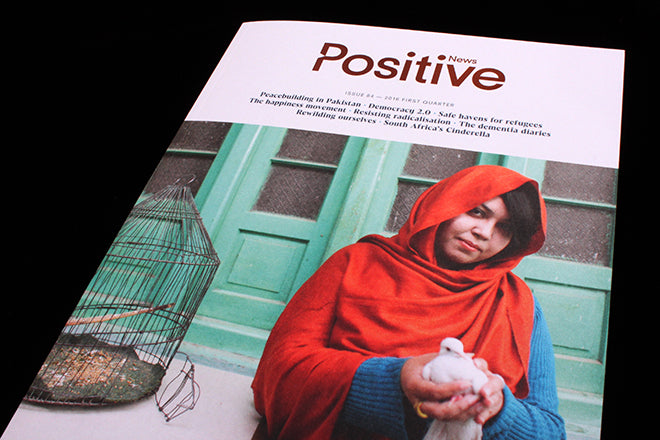
Positive News
Positive News was established in 1993 with an aim to report on inspirational issues and examine society’s challenges through a lens of progress and possibility. Originally printed as a newspaper, it was distributed for free and by volunteers. Now, it’s yet another example of an editorial venture that has decided to create its own independent magazine: it’s moved away from classic newsprint to a glossy, thick, paper-y format that looks at home alongside titles like Delayed Gratification, GOOD and Makeshift.
The change – initially funded by a recent crowd funding campaign – makes sense considering the publication’s raison-d’être. Its previous format did not especially reflect the point of view of the journalism – its emphasis on slowness and craft – as newspaper is so disposable.
‘Newspaper is more throwaway,’ agrees editor Sean Dagan Wood. ‘And it’s less about how something is presented. We wanted to do justice to our journalism and vision of our organization, and to create something with content that’s got deeper value.’ Medium and message now cohere.
Inspired by titles like Delayed Gratification, but also more lifestyle-focused publications such as Sidetracked, the Positive News team wanted to create something that combined the quality of journalism found in current affairs magazines and broadsheets such as The Guardian, with that same quality of design and packaging as found in independents.
‘We decided to work with Studio Blackburn on the design because they understood the values at the heart of Positive News, and they saw how to turn them most clearly into a visual identity,’ says Sean. The logotype and brand had to embody positive values and it had to hint to their focus on the future – the arrow shape within the capital ‘P’, which suggests moving forward and purpose, was one of the studio’s responses. Its idea was to also give the reader a sense of a light being switched on, and that’s why the studio designed two table-lamp symbols for the logo.
A second important reason why Positive News has shifted into the independent magazine market is to make its editorial output more financially viable. It’s one of the first global media companies find investment through crowd funding, and it’s also one of the first publications to be owned entirely by its readers. As Positive News is a co-operative, in doing a print magazine, Sean and his team saw the chance to ‘give back to our community.’
The magazine marks the beginning of a new business model for the company: to complement the new quarterly publication, Positive News are also focusing attention into the online platform, and are currently applying for funding to develop the new site. ‘As we’re co-op owned, we want to create new ways to engage our readers online,’ says Sean, hinting to the possibility of a platform that allows its community influence over content while still protecting the expertise of the editorial team.
‘We’ve always wanted to break down assumptions about what news should be and what it should look like,’ explains Sean, asserting that this new move into magazine making is another way to question and reassess the status quo of news reporting in a very changing time. ‘With all the changes that have happened in journalism, we want to ask, what is the point of it? We want to come back to purpose. To create something that inspires and empowers.’ Positive News decided that a carefully produced magazine format – especially with beautiful design –physically evokes those notions and ideals and can fit into the contemporary world.







